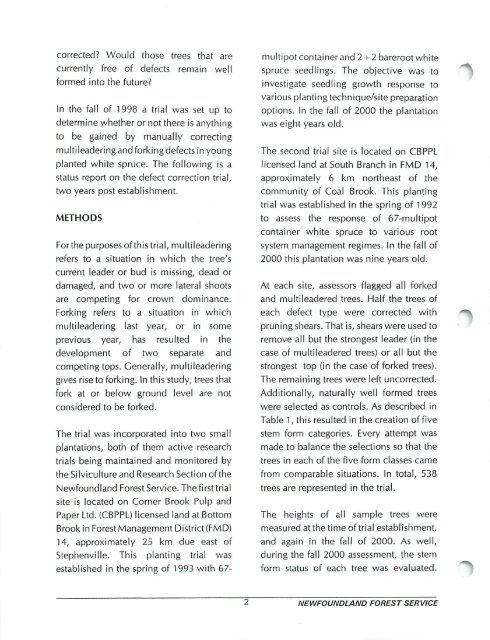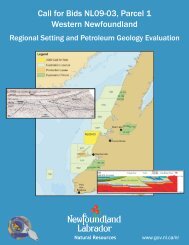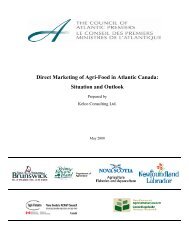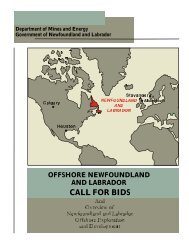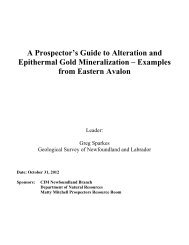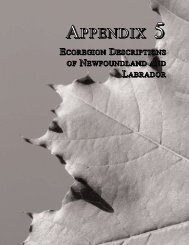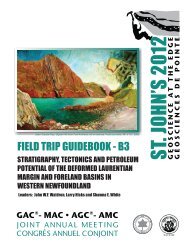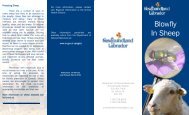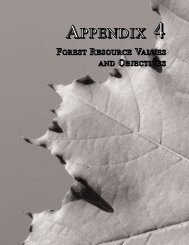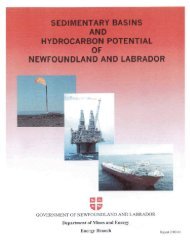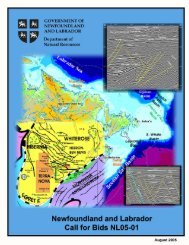Correcting stem deformities in juvenile planted white spruce
Correcting stem deformities in juvenile planted white spruce
Correcting stem deformities in juvenile planted white spruce
Create successful ePaper yourself
Turn your PDF publications into a flip-book with our unique Google optimized e-Paper software.
corrected? Would those trees that are<br />
currently free of defects rema<strong>in</strong> well<br />
formed <strong>in</strong>to the future?<br />
In the fall of 1998 a trial was set up to<br />
determ<strong>in</strong>e whether or not there is anyth<strong>in</strong>g<br />
to be ga<strong>in</strong>ed by manually correct<strong>in</strong>g<br />
multileader<strong>in</strong>g and fork<strong>in</strong>gdefects <strong>in</strong> young<br />
<strong>planted</strong> <strong>white</strong> <strong>spruce</strong>. The follow<strong>in</strong>g is a<br />
status report on the defect correction trial,<br />
two years post establishment.<br />
METHODS<br />
Forthe purposes of this trial, multileader<strong>in</strong>g<br />
refers to a situation <strong>in</strong> which the tree's<br />
current leader or bud is miss<strong>in</strong>g, dead or<br />
damaged, and two or more lateral shoots<br />
are compet<strong>in</strong>g for crown dom<strong>in</strong>ance.<br />
Fork<strong>in</strong>g refers to a situation <strong>in</strong> which<br />
multileader<strong>in</strong>g last year, or <strong>in</strong> some<br />
previous year, has resulted <strong>in</strong> the<br />
development of two separate and<br />
compet<strong>in</strong>g tops. Generally, multileader<strong>in</strong>g<br />
gives rise to fork<strong>in</strong>g. In this study, trees that<br />
fork at or below ground level are not<br />
considered to be forked.<br />
The trial was <strong>in</strong>corporated <strong>in</strong>to two small<br />
plantations, both of them active research<br />
trials be<strong>in</strong>g ma<strong>in</strong>ta<strong>in</strong>ed and monitored by<br />
the Silviculture and Research Section of the<br />
Newfoundland Forest Service. The first trial<br />
site is located on Corner Brook Pulp and<br />
Paper Ltd. (CBPPL) licensed land at Bottom<br />
Brook <strong>in</strong> Forest Management District (FMD)<br />
14, approximately 25 km due east of<br />
Stephenville. This plant<strong>in</strong>g trial was<br />
established <strong>in</strong> the spr<strong>in</strong>g of 1993 with 67-<br />
multipot conta<strong>in</strong>er and 2 + 2 bareroot <strong>white</strong><br />
<strong>spruce</strong> seedl<strong>in</strong>gs. The objective was to<br />
<strong>in</strong>vestigate seedl<strong>in</strong>g growth response to<br />
various plant<strong>in</strong>g technique/site preparation<br />
options. In the fall of 2000 the plantation<br />
was eight years old.<br />
The second trial site is located on CBPPL<br />
licensed land at South Branch <strong>in</strong> FMD 14,<br />
approximately 6 km northeast of the<br />
community of Coal Brook. This plant<strong>in</strong>g<br />
trial was established <strong>in</strong> the spr<strong>in</strong>g of 1992<br />
to assess the response of 67-multipot<br />
conta<strong>in</strong>er <strong>white</strong> <strong>spruce</strong> to various root<br />
sy<strong>stem</strong> management regimes. In the fall of<br />
2000 this plantation was n<strong>in</strong>e years old.<br />
At each site, assessors flagged all forked<br />
and multileadered trees. Half the trees of<br />
each defect type were corrected with<br />
prun<strong>in</strong>g shears. That is, shears were used to<br />
remove all but the strongest leader (<strong>in</strong> the<br />
case of multileadered trees) or all but the<br />
strongest top (<strong>in</strong> the case of forked trees).<br />
The rema<strong>in</strong><strong>in</strong>g trees were left uncorrected.<br />
Additionally, naturally well formed trees<br />
were selected as controls. As described <strong>in</strong><br />
Table 1, this resulted <strong>in</strong> the creation of five<br />
<strong>stem</strong> form categories. Every attempt was<br />
made to balance the selections so that the<br />
trees <strong>in</strong> each of the five form classes came<br />
from comparable situations. In total, 538<br />
trees are represented <strong>in</strong> the trial.<br />
The heights of all sample trees were<br />
measured at the time of trial establishment.<br />
and aga<strong>in</strong> <strong>in</strong> the fall of 2000. As well,<br />
dur<strong>in</strong>g the fall 2000 assessment, the <strong>stem</strong><br />
form<br />
status of each tree was evaluated.<br />
NEWFOUNDLAND FOREST SERVICE


